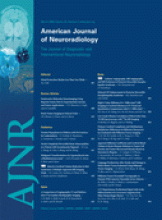Abstract
BACKGROUND AND PURPOSE: Vestibular schwannomas (VS) may be difficult to differentiate from cerebellopontine angle (CPA) meningiomas. Demonstration of microhemorrhages in VS on T2*-weighted gradient-echo (GRE) sequences may have potential value to differentiate VS from CPA meningiomas.
Materials and METHODS: In this prospective study of 20 patients, MR imaging was performed with T2*-weighted GRE in addition to all basic sequences. Histopathologic examination was performed after surgery. Intratumoral hemosiderin was confirmed by pigment staining.
RESULTS: There were 15 patients in the VS group with 16 VS and 5 in the meningioma group with 5 posterior fossa meningiomas. Fourteen of the 16 VS and all 5 meningiomas were treated surgically and were confirmed on histopathologic examination. T2*-weighted GRE identified microhemorrhages on T2*-weighted sequence in 15 (93.75%) of the 16 VS. CT excluded calcification in all VS. T2-weighted turbo spin-echo (TSE) and fluid-attenuated inversion recovery (FLAIR) images recognized microhemorrhages in 2 cases. Pigment staining confirmed hemosiderin in all 14 surgically treated VS, and none of the meningiomas showed microhemorrhages on MR imaging. For the detection of microhemorrhages, T2*-weighted GRE showed a sensitivity of 93.8%, specificity of 100%, positive predictive value of 100%, and negative predictive value of 83.3%. The sensitivity of T2 TSE and FLAIR for microhemorrhage was 12.5%. The Fisher exact test showed a statistically significant difference in the differentiation of VS from meningioma on the basis of detection of microhemorrhages (P < .01).
CONCLUSION: Most VS demonstrate microhemorrhages on T2*-weighted GRE. This finding is useful to differentiate VS from CPA meningiomas. T2*-weighted GRE should be used as a basic sequence to evaluate CPA tumors. Identification of microhemorrhages may have the potential to assess the aggressive biologic behavior of VS.
- Copyright © American Society of Neuroradiology












